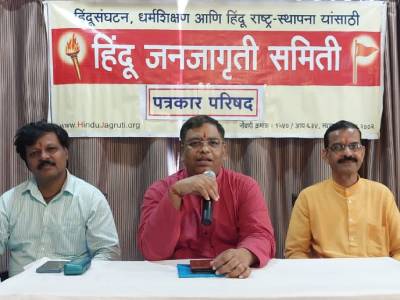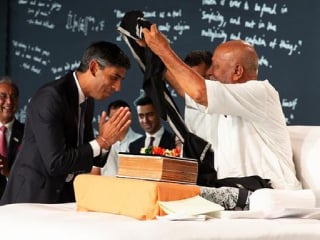
India has the largest number of cows and buffaloes in the world. It is home to one sixth of the world’s cows and half of world’s buffaloes. Panchgavya, the mixture of five cow products—milk, ghee (purified butter), yoghurt, urine and dung—is used for religious purification and different rituals. Besides, some of these products are used for making manure, pesticide, incense, tooth powder and bath-soap. Today, Panchgavya Ayurvedic Therapy is used for treatment of different diseases.
The practice of cow slaughter started in India, against the will of the people, at a time it was under foreign rule. One motive was to spoil native culture. Though India achieved independence in 1947, the rulers could not do anything to ban cow slaughter despite the growing demand for this from the people.
Today, there are around 3,600 legal slaughterhouses in India; while the number of illegal ones is nearly 30,000. India has turned out to be the largest beef exporter in the world, apart from being the fifth biggest consumer of beef. All this has happened at a great cost. The number of cattle in the country has been reduced to nearly 300 million, compared to nearly 900 million during its independence in 1947. The agricultural sector as well as the health of its people was compromised as the supply of cow-products was reduced. Also, it is feared, huge profits generated by illegal slaughterhouses are now being used to support terrorism.
But soon after the BJP government came to power in 2014, pressure started mounting in different corners of India to declare cow as Rashtra Mata (“Mother of the nation”) and to ban cattle slaughter at the national level. Over 100,000 responsible citizens and groups appealed to the Union government of India for this initiative. Accordingly, India’s Home Minister Raj Nath Singh had to make a visit to India-Bangladesh border and instruct the Indian Border Security Force to prevent Indian cows from crossing over into Bangladesh. Otherwise, over two million cattle used to be smuggled to Bangladesh from India every year.
As per the instruction of government of India, over 90,000 cattle have been seized by Indian Border Security Force in last few months as they were being smuggled to Bangladesh. Besides, 400 smugglers were arrested in this process. Notably, the cattle slaughter and other related industries in Bangladesh like beef processing, tanneries, bone crushing—together forms nearly three percent of the US $190-billion Bangladeshi economy.
Meanwhile, the Maharashtra State government banned the slaughter of cows, bulls and bullocks altogether, along with consumption and possession of meat, by amending Animal Preservation Act in March 2015. Any violation of the law in the state is liable to punishment of up to five years along with a fine of Rs 10,000. Cow slaughter is now a non-bailable offence in this state. In the process of implementation of the law, a number of people have been put behind bars on charge of possessing or selling beef. Police in certain areas have even asked locals who own cows to provide photographs of each animal to keep track of the bovines. Many people adhering to non-Hindu faiths also cooperated with the state government’s move to ban cow slaughter in order to promote communal harmony.
Soon after the move of Maharashtra government, the Haryana state government also imposed ban on cow slaughter. In this state, anyone found violating this law is liable to ten years jail plus fines. Now cow slaughter is banned in several states in India, including in Delhi, Goa, Gujarat, Karnataka, Madhya Pradesh, Orissa, Punjab, Rajasthan and Uttar Pradesh. But it is still practiced in Kerala, West Bengal and different north-eastern states.
Significantly, the cow preservation movement is gaining ground. A huge amount of money has been allocated for the preservation of indigenous cows. In order to give farmers the incentive to raise cattle, Maharashtra government provides subsidy on fertilizer, on the condition that cow urine and dung are used in manufacturing process. Plan is afoot to establish cattle shelters in each of its villages. Maharashtra government is taking a lead in this, but other state governments are also active in protecting cattle. Also, in Maharashtra, the government is in the process of establishing a cow progeny protection board.
Efforts made in certain Indian states to stop cattle slaughter, to ban beef sale, outlaw its possession and curb their smuggling from India to Bangladesh is appreciated by the Indian masses. Such measures would help save millions of cattle. However, cattle cannot remain safe until the slaughterhouses are banned at the national level in India. Partial ban on slaughterhouses, as we have seen, will not be very effective in controlling slaughter of innocent cattle.
Smuggling of cattle from Nepal to India would be somewhat reduced through above measures. But Nepal should take extra precaution to see that cattle smuggling is controlled on Nepal-India border for which security measures would have to be beefed up. Import of beef, which is quite rampant in Nepal, should be stopped, as per the sentiments of the people. Though beef happens to be the favorite food for certain people, research shows that beef is most hazardous to human health. In addition, the cattle meat industry is a major threat to the environment. So the sooner cattle slaughter is stopped, the better.
The author is Executive Director of Centre for Economic and Technical Studies in Nepal





